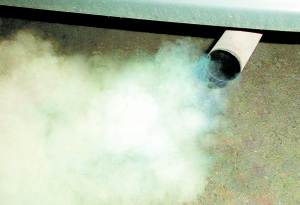
Photo: flickr.com
When looked at as a group, studies of attached garages offer helpful information about when and how carbon dioxide and fumes pollute the home.
Among the more interesting observations to come out of 20 years of research on attached garages is the fact that they have lousy energy efficiency. This makes sense of course. Few builders spend a lot of time insulating and sealing the garage. But blower door tests found that garages are often TEN TIMES leakier than the home they’re connected to. Even in the best case scenarios, they leak twice as much air.
But hold on, the next question is, “Do we really want garages to be as airtight as a home?” On a gut level, you might think, sure, I want the leakiest garage possible, so toxins will clear out naturally. But that’s not how it actually works. Air flows from higher pressure to lower pressure areas. We’ll get into that more below.
The ideal scenario is to have all airflow in all parts of a structure under the control of the occupant, not blowing wild. That’s why, in a tight, modern house, it’s essential to install mechanical ventilation (typically an HRV or ERV) so that toxins don’t have time reach high concentrations before the next air change.
One of the most comprehensive surveys of research on garages is still relevant, although it was conducted by the National Institute of Standards and Technology twelve years ago. The researchers found “substantial evidence that transport of contaminants from garages has the potential to negatively impact residential IAQ in either an acute (e.g., carbon monoxide from automobiles) or chronic manner (e.g., storage of chemical products).” One study tracked the specific types of VOCs and other toxins found indoors, and noted that up to 75% of all indoor pollutants could be traced directly to the same compounds being released in the attached garage. Some of these come from automobiles (the majority), but garages are notoriously polluted with dangerous compounds such as benzene, which has been found at dangerous levels in studies of home-garage-to- indoor air transmission. In fact, one study (Thomas, 1993) found that garage pollutants such as benzene can actually hit higher levels in the home than having someone smoke cigarettes indoors.
If you’re building, buying or remodeling a home with an attached garage, these are some key things you need to know.
1. Winter warning. Studies comparing pollution from vehicle tailpipes on cold mornings vs. warm days found a major difference in the amount of carbon monoxide (CO), carbon dioxide (CO2), volatile organic compounds (VOCs) and carbonyl compounds transferred to living areas in cold weather. Another study (Fugler, 2002) measured the average pressure difference between inside the home and the garage and arrived at 1.6 pascals in winter, .5 in summer, with the garage being the higher pressure in both cases.
2. Ventilating the garage helps (sometimes). Ventilating the garage directly can help, but only if the garage is sufficiently airtight that it can be depressurized separately from the house. Unfortunately, most garages fail this test. Fugler found, for example, that when they installed an automatic exhaust fan in garages that would operate for a few minutes after the vehicle started and continue after it left, at a speed of 100 l/s, it had little effect on the typical, leaky garage. But on a tighter garage, it proved quite effective.
3. Ventilating the home helps (somewhat). One test (Kaluza, 1999) of a whole-house ventilation system caused a 50 % reduction in the peak CO level in the home. Researchers found that when combined with an exhaust fan to keep the garage air pressure lower than the home, this kept 100% of the CO from migrating into living spaces.
4. Tighter home-garage wall interfaces help. Research suggests that it’s best to treat the attached garage like a completely separate system, not an “add-on” to the home’s mechanical system. Sure, you need to monitor pressure in both spaces, and keep the garage lower, but running exhaust ducts into garage spaces from the home mechanicals can invite trouble.
I wish there were a simple formula to fix every garage pollution problem, but especially in older homes, you need to first assess the biggest pathway for pollutants. Check the pressure difference between the two shells, and get your ventilation expert to balance it in favor of slightly higher pressure indoors. Control the air. Don’t let it run wild. That way, if there are airborne pollutants, you can send them outside, where they can do less harm.
References: http://bit.ly/1NiL8GB.
Reprinted with permission, courtesy of Green Builder Media: www.greenbuildermedia.com.








Leave a Reply